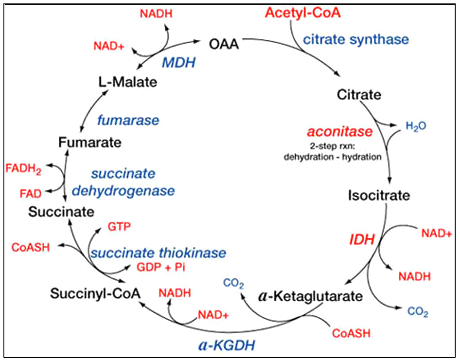
Concept explainers
(a)
Interpretation:
The name of four compounds with four carbon dicarboxylic acids in citric acid cycle should be given.
Concept Introduction:
Carboxylic acid: One
Citric Acid Cycle: It involves 8 series reaction which converts acetyl group present in acetyl coenzyme A into 2

Figure 1
(b)
Interpretation:
The four compound with four dicarboxylic acid groups present in citric acid cycle should be arranged from least to most oxidized.
Concept Introduction:
Carboxylic acid: One
Citric Acid Cycle: It involves 8 series reaction which converts acetyl group present in acetyl coenzyme A into 2
Oxidation: The oxidation is reaction that involves addition of oxygen atom or loss of electrons or removal of hydrogen atom present in the chemical compound.
Reduction: It involves removal of oxygen or addition of hydrogen to the chemical compound.
Want to see the full answer?
Check out a sample textbook solution
Chapter 21 Solutions
FUND.OF GEN CHEM CHAP 1-13 W/ACCESS
- The citric acid cycle can be divided into two stages. In one stage, carbon atoms are added and removed, and in the second stage, oxaloacetate is regenerated. Which steps of the citric acid cycle correspond to each stage?arrow_forwardWhat is the purpose of the citric acid cycle?arrow_forwardThe citric acid cycle operates only when O2 is present, yet O2 is not a substrate for the cycle. Explain.arrow_forward
- in steps 3 and 5 of the citric acid cycle, the compounds are shortended by one carbon each time. whst is the form of this one-carbon compound? what happens to it in the body?arrow_forwardWhich reaction in the citric acid cycle is most analogous to the oxidative decarboxylation of 6- phosphogluconate to ribulose 5-phosphate? What kind of enzymebound intermediate is formed in both reactions?arrow_forwardWhat step in the citric acid cycle in inhibited by fluorocitrate?arrow_forward
- What citric acid cycle enzyme is also a component of the electron-transport chain?arrow_forwardWhat reaction brings acetyl CoA into the citric acid cycle?arrow_forwardWhy is it that the carboxylate "ions" actually partake in the citric acid cycle ratherthan the carboxylic acid? Explain using an examplearrow_forward
 BiochemistryBiochemistryISBN:9781319114671Author:Lubert Stryer, Jeremy M. Berg, John L. Tymoczko, Gregory J. Gatto Jr.Publisher:W. H. Freeman
BiochemistryBiochemistryISBN:9781319114671Author:Lubert Stryer, Jeremy M. Berg, John L. Tymoczko, Gregory J. Gatto Jr.Publisher:W. H. Freeman Lehninger Principles of BiochemistryBiochemistryISBN:9781464126116Author:David L. Nelson, Michael M. CoxPublisher:W. H. Freeman
Lehninger Principles of BiochemistryBiochemistryISBN:9781464126116Author:David L. Nelson, Michael M. CoxPublisher:W. H. Freeman Fundamentals of Biochemistry: Life at the Molecul...BiochemistryISBN:9781118918401Author:Donald Voet, Judith G. Voet, Charlotte W. PrattPublisher:WILEY
Fundamentals of Biochemistry: Life at the Molecul...BiochemistryISBN:9781118918401Author:Donald Voet, Judith G. Voet, Charlotte W. PrattPublisher:WILEY BiochemistryBiochemistryISBN:9781305961135Author:Mary K. Campbell, Shawn O. Farrell, Owen M. McDougalPublisher:Cengage Learning
BiochemistryBiochemistryISBN:9781305961135Author:Mary K. Campbell, Shawn O. Farrell, Owen M. McDougalPublisher:Cengage Learning BiochemistryBiochemistryISBN:9781305577206Author:Reginald H. Garrett, Charles M. GrishamPublisher:Cengage Learning
BiochemistryBiochemistryISBN:9781305577206Author:Reginald H. Garrett, Charles M. GrishamPublisher:Cengage Learning Fundamentals of General, Organic, and Biological ...BiochemistryISBN:9780134015187Author:John E. McMurry, David S. Ballantine, Carl A. Hoeger, Virginia E. PetersonPublisher:PEARSON
Fundamentals of General, Organic, and Biological ...BiochemistryISBN:9780134015187Author:John E. McMurry, David S. Ballantine, Carl A. Hoeger, Virginia E. PetersonPublisher:PEARSON





